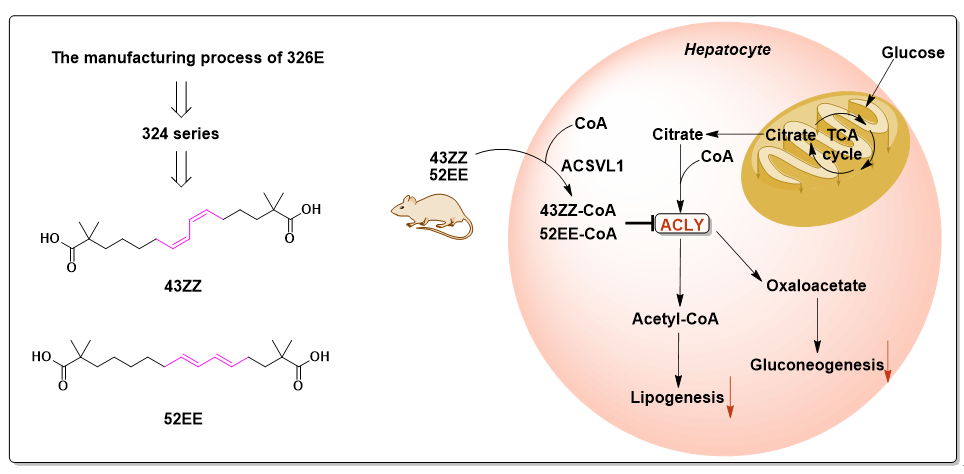[1] Moore M. C.; Coate K. C.; Winnick J. J.; An Z.; Cherrington, A. D. Adv Nutr.2012, 3, 286-294.
[2] Petersen M. C.; Vatner D. F.; Shulman, G. I. Nat. Rev. Endocrinol.2017, 13, 572-587.
[3] Tan M.; Mosaoa R.; Graham G. T.;Kasprzyk-Pawelec, A.; Gadre, S.; Parasido, E.; Catalina-Rodriguez, O.; Foley, P.; Giaccone, G.; Cheema, A.; Kallakury, B.; Albanese, C., Yi, C.; Avantaggiati, M. L. Cell Death Differ. 2020, 27, 2143-2157.
[4] Wei X.; Schultz K.; Bazilevsky G. A.; Vogt A.; Marmorstein, R. Nat. Struct. Mol. Biol.2020, 27, 33-41.
[5] Srere, P. A. J. Biol. Chem.1959, 234, 2544-2547.
[6] Lau F. D.; Giugliano, R. P. JAMA Cardiol.2023, 8, 879-887.
[7] Zaidi, N.; Swinnen, J. V.; Smans, K.; Cancer Res. 2012, 72, 3709-3714.
[8] Granchi, C.; Eur. J. Med. Chem. 2018, 157, 1276-1291.
[9] Pinkosky, S. L.; Groot, P. H. E.; Lalwani, N. D.; Trends Mol. Med. 2017, 23, 1047-1063.
[10] Feng X.-J.; Zhang L.; Xu S.-W.; Shen, A.-Z. Prog. Lipid Res.2020, 77, 101006.
[11] Morrow M. R.; Batchuluun B.; Wu J.; Ahmadi E.; Leroux J. M.; Mohammadi-Shemirani P.; Desjardins E. M.; Wang Z.; Tsakiridis E. E.; Lavoie D. C. T.; Reihani A.; Smith B. K.; Kwiecien J. M.; Lally J. S. V.; Nero T. L.; Parker M. W.; Ask K.; Scott J. W.; Jiang L.; Paré G.; Pinkosky, S. L; Steinberg G. R. Cell Metab.2022, 34, 919-936.
[12] Liang J.-J.; Zhou X.-F.; Long H.; Li C.-Y.; Wei J.; Yu X.-Q.; Guo Z.-Y.; Zhou Y.-Q.; Deng Z.-S. Bioorg. Chem.2024, 142, 106933.
[13] Li J.-J.; Wang H.; Tino J. A.; Robl J. A, Herpin T. F.; Lawrence R. M.; Biller S.; Jamil H.; Ponticiello R.; Chen L.; Chu C.-H.; Flynn N.; Cheng D.; Zhao R.; Chen B.; Schnur D.; Obermeier M. T.; Sasseville V.; Padmanabha R.; Pike K.; Harrity T. Bioorg. Med. Chem. Lett.2007, 17, 3208-3211.
[14] Wei J.; Leit S.; Kuai J.; Therrien E.; Rafi S.; Harwood H. J.; Jr, DeLaBarre B.; Tong L. Nature2019, 568, 566-570.
[15] Gribble A. D.; Ife R. J.; Shaw A.; McNair D.; Novelli C. E.; Bakewell S.; Shah V. P.; Dolle R. E.; Groot P. H.; Pearce N.; Yates J.; Tew D.; Boyd H.; Ashman S.; Eggleston D. S.; Haltiwanger R. C.; Okafo, G. J. Med. Chem.1998, 41, 3582-3595.
[16] Ray K. K.; Bays H. E.; Catapano A. L.; Lalwani N. D.; Bloedon L. T.; Sterling L. R.; Robinson P. L.; Ballantyne C. M.; CLEAR Harmony Trial. N. Engl. J. Med.2019, 380, 1022-1032.
[17] Goldberg A. C.; Leiter L. A.; Stroes E. S. G.; Baum S. J.; Hanselman J. C.; Bloedon L. T.; Lalwani N. D.; Patel P. M.; Zhao, X., Duell, P. B. JAMA.2019, 322, 1780-1788.
[18] Pinkosky S. L.; Newton R. S.; Day E. A.; Ford R. J.; Lhotak S.; Austin R. C.; Birch C. M.; Smith B. K.; Filippov S.; Groot P. H. E.; Steinberg G. R.; Lalwani, N. D. Nat. Commun.2016, 7, 13457.
[19] Xie Z.-F.; Zhang M.; Song Q.; Cheng L.; Zhang X.-W.; Song G.-L.; Sun X.-Y.; Gu M.; Zhou C.-D.; Zhang Y.-M.; Zhu K.-X.; Yin J.-P.; Chen X.-Y.; Li J.-Y.; Nan, F.-J. Acta. Pharm. Sin. B.2023, 13, 739-753.
[20] Song G.-L.; Cao L.; Zhang M.; Yang Y.-R.; Ma J.; Xie Z.-F.; Li J.-Y.; Nan, F.-J. Chin. J. Chem.2022, 40, 2663-2670.
[21] Wang G -W.; Mohan S.; Negishi, E. Proc Natl Acad Sci U S A.2011, 108, 11344-11349.
[22] Wang Y. D.; Kimball G.; Prashad A. S.; Wang Y. Tetrahedron Lett.2005, 46, 8777-8780.
[23] Ren G.-B.; Wu Y -K. Tetrahedron.2008, 64, 4408-4415.
[24] Molander G. A.; Trice S. L.; Kennedy, S. M. J Org Chem.2012;77, 8678-8688.
[25] Suh Y. G.; Min K. H.; Lee Y. S.; Seo S. Y.; Kim S. H.; Park, H. J. Tetrahedron Lett.2002, 43, 3825-3828.
[26] Zhao S.; Jang C.; Liu J.; Uehara K.; Gilbert M.; Izzo L.; Zeng X.; Trefely S.; Fernandez S.; Carrer A.; Miller K. D.; Schug Z. T.; Snyder N. W.; Gade T. P.; Titchenell P. M.; Rabinowitz J. D.; Wellen K. E. Nature2020, 579, 586-591.
[27] Softic S.; Cohen D. E.; Kahn, E. R. Dig. Dis. Sci.2016, 61, 1282-1293.
[28] Pinkosky S. L.; Filippov S.; Srivastava R. A.; Hanselman J. C.; Bradshaw C. D.; Hurley T. R.; Cramer C. T.; Spahr M. A.; Brant A. F.; Houghton J. L.; Baker C.; Naples M.; Adeli K.; Newton, R. S. J. Lipid Res.2013, 54, 131-151.
[29] Li W -C.; Ralphs K. L.; Tosh, D. Methods Mol Biol.2010, 633, 185-196. |
